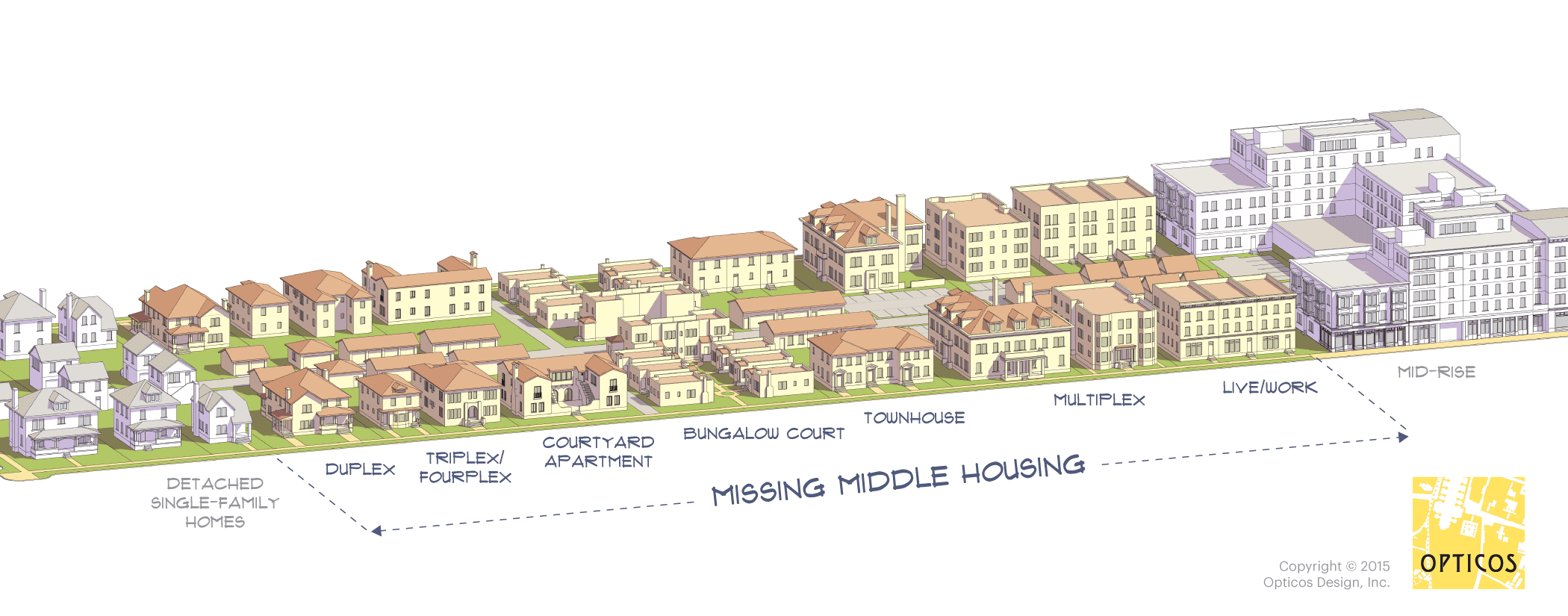Building the infrastructure for walkable cities
Our mission: create more walkable, sustainable communities where people can live, work, and thrive without car dependency.
What is Missing Middle Housing?
The "missing middle" refers to a range of multi-unit or clustered housing types compatible with the scale of single-family neighborhoods.

Housing Types
These buildings typically house between 2-12 families and fit seamlessly into existing neighborhoods without dramatically changing their character.
Why "Missing"?
Historically common: These housing types were the backbone of American neighborhoods before World War II.
Zoned out, until recently: Post-war zoning codes largely prohibited them, creating a gap between single-family homes and large apartment buildings. With reform, delivery remains challenging due to regulatory complexity.
The Sweet Spot for Walkable Cities
Missing middle housing provides the "gentle density" needed to support local businesses, transit, and walkable amenities while maintaining the human scale that makes neighborhoods livable. It's dense enough to be sustainable, but small enough to feel like home.
Why Walkable Cities Matter
The climate crisis demands walkable neighborhoods. Transportation is 29% of U.S. emissions, and suburban sprawl forces car dependency. Missing middle housing creates the density needed for transit, walkability, and community.
The Global Solution
Cities in Europe prove it works. Human-scale buildings create vibrant streetscapes where daily needs are within walking distance. This isn't just better for the planet, it's better for people.
But delivery is the bottleneck. Zoning reform enabled missing middle housing, but regulatory complexity prevented it from being built. Corbu exists to solve this delivery gap.
Walkability Impact Metrics
Our Story
The path to building Corbu.
Life Without Cars
"Saturday morning, walking to the farmer's market." No parking, no traffic. Just steps outside, joining neighbors on tree-lined streets with corner cafes and local shops.
In some cities, this is daily life. And it is transformative. Stronger community connections. Lower stress. Economic vibrancy. A fundamentally more sustainable way of living.
What Made It Work
Life Across America
"Why isn't this being built here?"
The demand is clear: people want walkable neighborhoods. Cities have legalized this type of housing. Climate urgency is mounting. Yet despite all these tailwinds, the housing isn't getting built.
The missing piece isn't policy or demand: it's delivery infrastructure.
Building the Infrastructure
We decided to build what's missing. Not another software tool or consultancy, but the complete delivery system that accelerates the developer-to-capital process.
We offer expert-led services that compress timelines from weeks to days. AI-powered underwriting that improves returns. Investment capital that enables development. This dual approach addresses both the bottleneck and the capital gap that prevents walkable neighborhoods from getting built.
We're accelerating the delivery of housing America needs.
Our Fund
Beyond services, we invest directly in this future. Missing middle housing sits at the intersection of massive demand, policy tailwinds, and a delivery gap that creates extraordinary opportunities for those who can execute.
The Investment Thesis
Missing middle housing represents a massive opportunity. Demand for walkable neighborhoods far exceeds supply, yet traditional financing struggles with the complexity of multi-unit projects.
We bridge the gap between developers and capital. Our tech-enabled services de-risk projects for lenders and investors, while our fund provides direct financing for developments we've vetted through our own process.